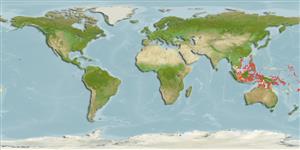>
Gobiiformes (Gobies) >
Gobiidae (Gobies) > Gobiinae
Etymology: Asterropteryx: Greek, a = with + Greek, sterros, -a, -on = consistent + Greek, pteryx = fin (Ref. 45335).
Environment: milieu / climate zone / depth range / distribution range
Ecología
marino asociado a arrecife; rango de profundidad 6 - 30 m (Ref. 31115). Tropical
Western Central Pacific: Indonesia, Papua New Guinea, and the Indo-Australian Archipelago.
Tamaño / Peso / Age
Maturity: Lm ? range ? - ? cm
Max length : 2.3 cm SL macho / no sexado; (Ref. 31115)
Short description
Morfología | Morfometría
Espinas dorsales (total): 7; Radios blandos dorsales (total): 10; Espinas anales 1; Radios blandos anales: 9. Body whitish with a broad dark brown stripe from snout to base of caudal fin. Preopercle spines, 4-5. Ctenoid scales on head, cheek, opercle, and rest of the body except on pectoral base and prepelvic region where it is cycloid (Ref. 31115); characterized further by absence of prolonged spines; longitudinal scale series 24; 4-5 weak spines on rear edge of preopercle, similar size all spines; rounded caudal fin; depth of body 3.3-4.0 in SL (Ref. 90102).
Inhabits rubble bottoms in lagoons and sheltered coastal reefs. Typically hovers a short distance above the bottom, apparently to feed on zooplankton (Ref. 31115). Solitary or in small group (Ref 90102).
Life cycle and mating behavior
Madurez | Reproducción | Puesta | Huevos | Fecundidad | Larva
Allen, G.R. and P. Munday, 1995. Description of four new Gobies (Gobiidae) from the Western Pacific Ocean. Rev. Fr. Aquariol. 22(3-4):99-104. (Ref. 31115)
IUCN Red List Status (Ref. 130435)
Threat to humans
Harmless
Human uses
Más información
Nombres comunesSinónimosMetabolismoDespredadoresEcotoxicologíaReproducciónMadurezPuestaAgregación para la puestaFecundidadHuevosEgg development
Age/SizeCrecimientoLength-weightLength-lengthLength-frequenciesMorfometríaMorfologíaLarvaDinámica larvariaReclutamientoAbundanciaBRUVS
ReferenciasAcuiculturaPerfil de acuiculturaRazasGenéticaElectrophoresesheritabilidadEnfermedadesProcesamientoNutrientsMass conversion
ColaboradoresImágenesStamps, Coins Misc.SonidosCiguateraVelocidadTipo de nataciónSuperficie branquialOtolitosCerebrosVisión
Herramientas
Special reports
Download XML
Fuentes de Internet
Estimates based on models
Preferred temperature (Ref.
123201): 27 - 29.3, mean 28.7 °C (based on 1066 cells).
Phylogenetic diversity index (Ref.
82804): PD
50 = 0.5039 [Uniqueness, from 0.5 = low to 2.0 = high].
Bayesian length-weight: a=0.00708 (0.00333 - 0.01504), b=3.09 (2.92 - 3.26), in cm total length, based on LWR estimates for this (Sub)family-body shape (Ref.
93245).
Nivel trófico (Ref.
69278): 3.4 ±0.45 se; based on food items.
Resiliencia (Ref.
120179): Alto, población duplicada en un tiempo mínimo inferior a 15 meses (Preliminary K or Fecundity.).
Fishing Vulnerability (Ref.
59153): Low vulnerability (10 of 100).
Nutrients (Ref.
124155): Calcium = 413 [181, 1,403] mg/100g; Iron = 1.81 [0.75, 4.07] mg/100g; Protein = 17.4 [15.3, 19.3] %; Omega3 = 0.108 [0.033, 0.326] g/100g; Selenium = 33.2 [9.1, 107.5] μg/100g; VitaminA = 189 [41, 912] μg/100g; Zinc = 4.15 [2.21, 7.04] mg/100g (wet weight);
